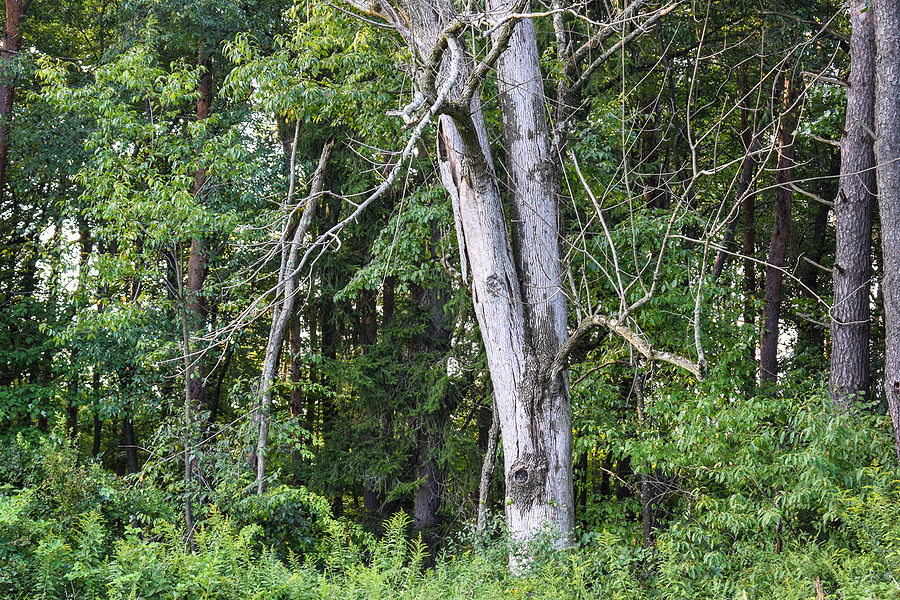Emerald ash borer (EAB) infestations have wreaked havoc on millions of ash trees across the United States, making it one of the most destructive forest pests in the country. The loss of these trees not only alters the landscape but disrupts entire ecosystems and has profound effects on our urban environments. This blog post is designed to arm homeowners and gardeners with the knowledge and tools necessary to protect these vital contributors to our green spaces from the relentless threat of the emerald ash borer.

Understanding the Emerald Ash Borer
Native to eastern Asia, the emerald ash borer is a metallic, shiny green beetle that feeds on and lays its eggs in ash trees, interfering with the tree’s ability to transport water and nutrients. Its life cycle begins as larvae hatching under the bark, where they tunnel and feed, eventually emerging as adults to continue the cycle. The effects of an EAB infestation can be devastating, often leading to a tree’s demise in just a few years.
Signs of an Emerald Ash Borer Infestation
Homeowners can spot EAB infestations by looking for the following signs:
- Canopy Dieback: The top of the tree may show signs of decline, with dead branches and barren patches in the leaves.
- Vertical Splits in Bark: EAB larval tunnels cause visible damage, often leading to splits in the bark as the infestation worsens.
- Increased Woodpecker Activity: Woodpeckers are natural predators of EAB larvae and will often target infected trees, leaving noticeable holes in the bark.
If left untreated, these signs typically lead to the irreversible decline of the ash tree.
The Importance of Managing EAB Infestations
The value of ash trees can’t be overstated—they provide shade, mitigate pollution, contribute to soil health, and support a variety of wildlife. As natural filters for air and water, they’re essential to the health of our ecosystems. Managing EAB is crucial to preserving these roles and maintaining the integrity of our natural and urban landscapes.
The Role of Trees in Our World
Ash trees are essential components of our environment for several reasons. They offer habitat and sustenance to countless species, including birds and insects that rely on them for survival. They also help prevent erosion, sequester carbon, and contribute to a healthy environment in many urban and suburban settings.
Why Immediate Action is Necessary
Once infested, ash trees can become hazardous, as they become brittle and can pose a threat to people and property. Prompt management is key to reduce the spread and protect other ash trees in the community.
Proactive Tree Care Measures for Homeowners
If you have ash trees on your property, there are proactive steps you can take to mitigate the risk of an EAB infestation and, if caught early, potentially save the tree.
Tree Identification – Knowing whether you have ash trees is the first step. Look for trees with compound leaves and an opposite branching pattern—all features characteristic of ash species.
Treatment Options – There are several treatment options for homeowners, including sprays and soil drenches. It’s important to choose the right treatment and apply it correctly to maximize effectiveness and minimize harm to beneficial insects and other organisms.
Professional Assistance – In some cases, the size or health of the tree may necessitate the expertise of a professional arborist. These specialists can assess the situation and recommend a treatment plan tailored to your specific needs.
Sustainable Tree Pest Protection Solutions
As our understanding of EAB and its effects grows, so does the development of sustainable management solutions that lessen environmental impact.
Biological Control – Biological control methods involve introducing natural predators of the EAB to keep populations in check. This approach can take time to show results but is a promising long-term strategy.
Tree Injections – Tree injections, also known as trunk injections, deliver insecticides directly into the tree’s vascular system. This method is highly effective and has the benefit of minimizing environmental exposure.
In Summary
Emerald ash borers present a significant challenge to homeowners and communities, but with the right knowledge and approach, we can protect our ash trees and the environment they support. Early detection, prompt action, and sustainable management techniques can turn the tide against this invasive pest.
By investing the time and resources to manage EAB, we invest in a greener, healthier future for our communities. If you suspect an EAB infestation in your ash trees, don’t delay—seek professional assistance, and take the necessary steps to protect your valuable green assets. After all, the health of our environment is a collective responsibility and starts right in our own back.
Ready to get rid of your tree pest and disease problems? Contact Complete Tree Care at 317-783-2518 to get assistance from a certified arborist in Indianapolis, Indiana. We serve residential and commercial clients with comprehensive tree care solutions.
Related Posts:
Learn How to Identify Ash Trees
Common Winter Tree Pests in Indiana
Tree Troubles: Identifying and Treating Common Tree Diseases in Indiana
